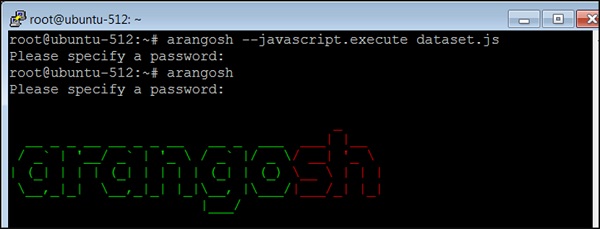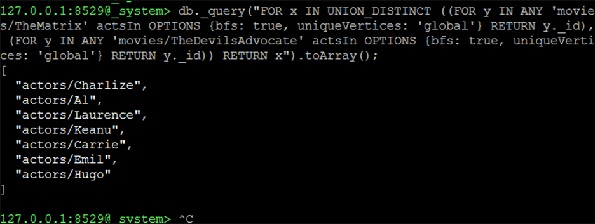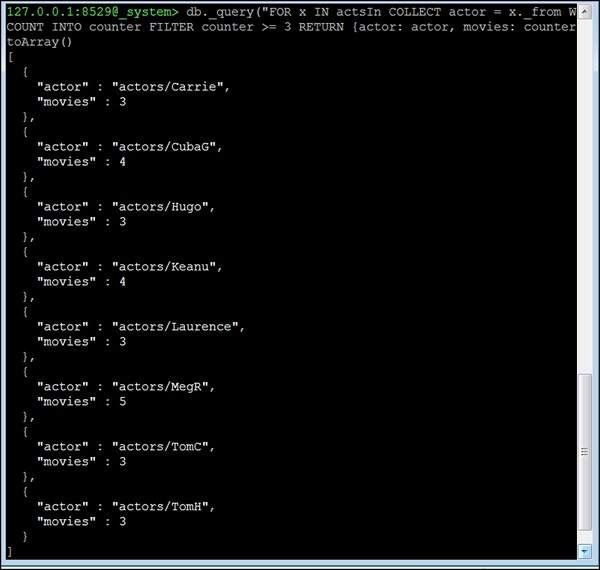arangodb
Khóa học miễn phí ArangoDB – AQL Example Queries nhận dự án làm có lương
ArangoDB – AQL Example Queries
In this chapter, we will consider a few AQL Example Queries on an Actors and Movies Database. These queries are based on graphs.
Problem
Given a collection of actors and a collection of movies, and an actIn edges collection (with a year property) to connect the vertex as indicated below −
[Actor] <- act in -> [Movie]
How do we get −
- All actors who acted in “movie1” OR “movie2”?
- All actors who acted in both “movie1” AND “movie2”?
- All common movies between “actor1” and “actor2”?
- All actors who acted in 3 or more movies?
- All movies where exactly 6 actors acted in?
- The number of actors by movie?
- The number of movies by actor?
- The number of movies acted in between 2005 and 2010 by actor?
Solution
During the process of solving and obtaining the answers to the above queries, we will use Arangosh to create the dataset and run queries on that. All the AQL queries are strings and can simply be copied over to your favorite driver instead of Arangosh.
Let us start by creating a Test Dataset in Arangosh. First, download −
# wget -O dataset.js
Output
... HTTP request sent, awaiting response... 200 OK Length: unspecified [text/html] Saving to: ‘dataset.js’ dataset.js [ <=> ] 115.14K --.-KB/s in 0.01s 2017-09-17 14:19:12 (11.1 MB/s) - ‘dataset.js’ saved [117907]
You can see in the output above that we have downloaded a JavaScript file dataset.js. This file contains the Arangosh commands to create the dataset in the database. Instead of copying and pasting the commands one by one, we will use the –javascript.execute option on Arangosh to execute the multiple commands non-interactively. Consider it the life saver command!
Now execute the following command on the shell −
$ arangosh --javascript.execute dataset.js

Supply the password when prompted as you can see in the above screenshot. Now we have saved the data, so we will construct the AQL queries to answer the specific questions raised in the beginning of this chapter.
First Question
Let us take the first question: All actors who acted in “movie1” OR “movie2”. Suppose, we want to find the names of all the actors who acted in “TheMatrix” OR “TheDevilsAdvocate” −
We will start with one movie at a time to get the names of the actors −
127.0.0.1:8529@_system> db._query("FOR x IN ANY ''movies/TheMatrix'' actsIn
OPTIONS {bfs: true, uniqueVertices: ''global''} RETURN x._id").toArray();
Output
We will receive the following output −
[ "actors/Hugo", "actors/Emil", "actors/Carrie", "actors/Keanu", "actors/Laurence" ]

Now we continue to form a UNION_DISTINCT of two NEIGHBORS queries which will be the solution −
127.0.0.1:8529@_system> db._query("FOR x IN UNION_DISTINCT ((FOR y IN ANY
''movies/TheMatrix'' actsIn OPTIONS {bfs: true, uniqueVertices: ''global''} RETURN
y._id), (FOR y IN ANY ''movies/TheDevilsAdvocate'' actsIn OPTIONS {bfs: true,
uniqueVertices: ''global''} RETURN y._id)) RETURN x").toArray();
Output
[ "actors/Charlize", "actors/Al", "actors/Laurence", "actors/Keanu", "actors/Carrie", "actors/Emil", "actors/Hugo" ]

Second Question
Let us now consider the second question: All actors who acted in both “movie1” AND “movie2”. This is almost identical to the question above. But this time we are not interested in a UNION but in an INTERSECTION −
127.0.0.1:8529@_system> db._query("FOR x IN INTERSECTION ((FOR y IN ANY
''movies/TheMatrix'' actsIn OPTIONS {bfs: true, uniqueVertices: ''global''} RETURN
y._id), (FOR y IN ANY ''movies/TheDevilsAdvocate'' actsIn OPTIONS {bfs: true,
uniqueVertices: ''global''} RETURN y._id)) RETURN x").toArray();
Output
We will receive the following output −
[ "actors/Keanu" ]

Third Question
Let us now consider the third question: All common movies between “actor1” and “actor2”. This is actually identical to the question about common actors in movie1 and movie2. We just have to change the starting vertices. As an example, let us find all the movies where Hugo Weaving (“Hugo”) and Keanu Reeves are co-starring −
127.0.0.1:8529@_system> db._query(
"FOR x IN INTERSECTION (
(
FOR y IN ANY ''actors/Hugo'' actsIn OPTIONS
{bfs: true, uniqueVertices: ''global''}
RETURN y._id
),
(
FOR y IN ANY ''actors/Keanu'' actsIn OPTIONS
{bfs: true, uniqueVertices:''global''} RETURN y._id
)
)
RETURN x").toArray();
Output
We will receive the following output −
[ "movies/TheMatrixReloaded", "movies/TheMatrixRevolutions", "movies/TheMatrix" ]

Fourth Question
Let us now consider the fourth question. All actors who acted in 3 or more movies. This question is different; we cannot make use of the neighbors function here. Instead we will make use of the edge-index and the COLLECT statement of AQL for grouping. The basic idea is to group all edges by their startVertex (which in this dataset is always the actor). Then we remove all actors with less than 3 movies from the result as here we have included the number of movies an actor has acted in −
127.0.0.1:8529@_system> db._query("FOR x IN actsIn COLLECT actor = x._from WITH
COUNT INTO counter FILTER counter >= 3 RETURN {actor: actor, movies:
counter}"). toArray()
Output
[
{
"actor" : "actors/Carrie",
"movies" : 3
},
{
"actor" : "actors/CubaG",
"movies" : 4
},
{
"actor" : "actors/Hugo",
"movies" : 3
},
{
"actor" : "actors/Keanu",
"movies" : 4
},
{
"actor" : "actors/Laurence",
"movies" : 3
},
{
"actor" : "actors/MegR",
"movies" : 5
},
{
"actor" : "actors/TomC",
"movies" : 3
},
{
"actor" : "actors/TomH",
"movies" : 3
}
]

For the remaining questions, we will discuss the query formation, and provide the queries only. The reader should run the query themselves on the Arangosh terminal.
Fifth Question
Let us now consider the fifth question: All movies where exactly 6 actors acted in. The same idea as in the query before, but with the equality filter. However, now we need the movie instead of the actor, so we return the _to attribute −
db._query("FOR x IN actsIn COLLECT movie = x._to WITH COUNT INTO counter FILTER
counter == 6 RETURN movie").toArray()
The number of actors by movie?
We remember in our dataset _to on the edge corresponds to the movie, so we count how
often the same _to appears. This is the number of actors. The query is almost identical to
the ones before but without the FILTER after COLLECT −
db._query("FOR x IN actsIn COLLECT movie = x._to WITH COUNT INTO counter RETURN
{movie: movie, actors: counter}").toArray()
Sixth Question
Let us now consider the sixth question: The number of movies by an actor.
The way we found solutions to our above queries will help you find the solution to this query as well.
db._query("FOR x IN actsIn COLLECT actor = x._from WITH COUNT INTO counter
RETURN {actor: actor, movies: counter}").toArray()
Khóa học lập trình tại Toidayhoc vừa học vừa làm dự án vừa nhận lương: Khóa học lập trình nhận lương tại trung tâm Toidayhoc
Notice: Trying to access array offset on value of type bool in /home/edua/htdocs/edu.toidayhoc.com/wp-content/themes/flatsome/flatsome/inc/shortcodes/share_follow.php on line 41
